
by Lidia Paulinska | Apr 30, 2017
Fathom events, April – Pyotr Ilyich Tchaikovsky’s masterful Eugene Onegin, Op. 24, an opera in three acts and seven scenes, was presented live from the Metropolitan Opera in New York as part of the Live from the Met Series for a one-time only screening on Saturday, April 22, 2017. The libretto, adapted by the composer himself, closely follows Alexander Pushkin’s (1799-1837) classic poetic novel by the same name. Pushkin’s personal life was not without drama, for he was fatally wounded in a duel with his brother-in-law, a French officer serving with the Chevalier Guard Regiment (created by Catherine the Great in 1764), who was rumored to be having an intrigue amorous with Pushkin’s wife, Natalia Pushkina.
Eugene Onegin had its premiere in Moscow, March 29, 1879 at the Maly Theatre. The American premiere was given on March 24, 1920 at the Metropolitan Operas in New York at which time it was sung in Italian rather than the traditional Russian.
The current production has a distinctive Russian “feel” to it, with costumes and setting reminiscent of a Chekhov play. In fact, Prince Gremin’s aria, “To love both young and old surrender” from Act III, Scene 1, is actually hummed by the characters Vershinin and Masha in Anton Chekhov’s masterpiece, Three Sisters.
The time and place of the action is a St Petersburg dacha (country estate) and surrounding countryside in the 1820s. Tchaikovsky’s story line is faithful to Pushkin’s novel. Madame Larina, a widow (uncredited in film’s info sheet), has two daughters: the shy and romantic Tatiana, sung by Anna Netrebko, who spends her time reading novels, presumably “romantic,” and her free-spirited younger sister Olga, sung by Elena Maximova. Olga is being courted by their neighbor, a young, naive poet named Lenski, sung by Alexey Dolgov. Lens visits with his aristocratic, boorish and arrogant friend Eugene Onegin with whom Tatiana instantly falls in love.
In the second act, Onegin reluctantly accompanies Lenski to Tatiana’s name day celebration. Bored by the event, he distracts himself by flirting with Olga which infuriates Lenski and prompts him to challenge Onegin to a duel in which Lenski is killed, an irony that foreshadows Pushkin’s own demise.
Act III takes place several years later. Upon returning to St Petersburg after traveling abroad, Onegin attends a ball at which Prince Gremin introduces his young wife. Much to Oregon’s astonishment, he recognizes her as Tatiana and now realizes he actually does love her. He sends her an impassioned love letter, begging her to leave the Prince and run away with him. Tatiana confesses she still loves him but cannot leave her husband. Onegin is thus left desperate, and alone.
Curtain.
This strong musical production, featuring Tchaikovsky’s magnificent score and fine orchestration provided by Maestro Robin Ticciati, with much vocal virtuosity by the cast, suffered considerably due to the lifeless and bland production provided by Deborah Warner with sets by Tom Pye. The sunroom windows and doors of the dacha, for example, were completely draped with lifeless canvas from floor to imagined ceiling (the set had no walls or ceiling to help project the voices into the house). The drearily drab canvas not only deadened the vocal projection of the singers, but also visually presented an unremittingly dull and wearisome backdrop which was not changed for all three scenes of Act I. The extraordinary singers deserved better.
Otherwise, this “Onegin” was a worthy effort on the part of the inimitable Met and a valuable experience for opera cinema lovers world-wide who might not otherwise have the opportunity to experience a live performance from the world-renowned Met.
by Lidia Paulinska and Hugh McMahon

by Lidia Paulinska | Apr 21, 2017
April, HardwareCon – Something truly remarkable is happening across hardware – stated Mark Hindsbo from Ansys, in his opening keynote speech at HardwareCon 2017 that took place March 24-25 in San Leandro, California. Hindsbo referred to the megatrends including IoT that is being applied to make devices smarter; composite materials, that allow for the creation of new complex shapes and application flexibilities that were not possible before and new processes such as 3D printing which is leading the new area of additive manufacturing. All of them have been creating many exciting opportunities across hardware. Hindsbo explained that analysts, such as the Boston Consulting group, estimated this new industry sector to be $11 trillion by 2025.
This year HardwareCon event is now part of Hardware Massive and their global community. At the event, the show welcome had a show of hands response that identified close to half of the attendees were non-local to the Silicon Valley area, including Europe, Asia and South America. The event focused on innovators and their products that are all hardware based solutions for the industrial and retail sales channels. The common theme of hardware development brought a keynote from Ansys Corporation that was highlighting their startups program, and the advantages of using a computer to test out design in advance of making the prototypes.
Coverage of the event in the form of highlights from the Keynote, a one-on-one discussion with Mark Hindsbo and an overview of the exhibits as described by the innovators themselves appears on the Bright Blue Innovation television program produced by Roadway Media. In this episode made its appearance: Ansys Corp., Hello Axis, Theia, San Leandro Next, Product Realization Grop, Berkeley Sourcing Group, Skunk Lock, Rush Order, First Cinema, Alex Witkowski Law, Tindie, Bullz-I, Brain Portal, Tittle Light, Looksee, CloudKeyz and Recreation Sound.
http://roadway.media/bright-blue-innovation/bright-blue-innovation-season-2-spring-2017/bbi-s2-ep6-hardwarecon-2017/

by Lidia Paulinska | Apr 18, 2017
Fathom events, April – On Sunday, April 9, 2017, live from Moscow, thousands of movie-goers throughout the United States and abroad were treated to a one-time cinema viewing of A Hero of Our Time, the final ballet of the Bolshoi’s 2016-2017 Season. The splendid production was presented by Fathom Events, the indispensable conduit of cultural treasures with worldwide distribution and production by Pathé Live.
The ballet in three acts was choreographed by Yuri Possokhov with music by Ilya Demutsky and is based on a novel made up of five novellas by Mikhail Lermontov (1814-1841), a Russian writer and poet considered to be second only to Pushkin. Lermontov’s so-called “Superfluous man” novel features a classic Byronic hero (or anti-hero) by the name of Pechorin who in the ballet adaptation is represented by three different dancers in each of three act. (Vladimir Nabacov rendered English translation of the novel in 1958.) The three novellas adapted from the novel were “Bela,” “Taman,” and the longest of the short stories, “Princess Mary.”
The ballet is superb in all its manifestations on the Bolshoi’s wonderful new stage. The choreography is strong, crisp, and innovative and each of the three acts stand alone in style and tone from each other. However, therein lies a potential problem for an audience unfamiliar with Lermontov’s collection of novellas. The main source of potential confusion is the fact that the protagonist, Pecheron, is performed by three different dancers in each of the three acts: Act one features Igor Tsvirko, act two is danced by Artem Ovacharenko, and act three performed by Ruslan Skvortsov, all wonderfully powerful, precision dancers in the grand tradition of the incomparable Bolshoi.
The three acts have a continuity of character portrayal (Pecheron), but differ markedly in style and tone which may add to possible confusion. Each of the three interpretations of Pecheron shows a side of his character which is influenced by age and experience. In “Bela” he appears indifferent to Bela, danced by Olga Smirnova, but is remorseful in a solo performance after her death. In “Taman,” so name for a small coastal town by the Black Sea, is home to a group of shady smugglers whom our hero gets involved with. Fearing that Pecheron will alert the authorities of their nefarious activitiea, a young woman named Undine, danced with purposeful strength by Eketertina Shipulina, attempts to drown him. Escaping, he winds up in a spa town for rehabilitating army officers. Pecheron flirts with Princess Mary , performed by Svetlana Zakharova, who falls in love with him, but he was merely toying with her affections and has no romantic interest in her. He is challenged to a duel by her frustrated boyfriend whom he kills. He ultimately loses his true love Vera, danced by Kristina Kretova, and lives on in despair as a matured and self-reflective “hero.”
The male dancers of course are as strong as usual, but it’s the ballerinas who shine in this production. Olga Smirnov as Bela is convincing as a young innocent woman who is given to Pecheron in exchange for a horse. As act one opens, she is covered in a blanket and is both vulnerable and mysterious. Her dancing is fluid and alluring beautiful. Ekaterina Shipulina appears as the femme fatale Undine in act two, a passionate red-swan-like force, danced with strength and conviction. The graceful Svetina Zakhaorova performs the naive Princess Mary with style and grace, and as Pecheron’s only true love, Kristina Kretova’s Vera performs a dark and melodramatic solo that stands out as one of the most profoundly emotional and memorable moments in the ballet.
Atmosphere is very important in the novel and in this production itself and is well-expressed in the modern stage sets and Ilya Demusky’s varied and haunting score. Each act opens with a solo performance accompanied on stage by a solo musician or opera singer which has a haunting impact. Russian folk influences are apparent in Caucasus of act one. Act two the set designer (uncredited in the cinema info sheet) create hints of a small, harsh village represented by construction-like scaffolding and an ominous chorus of smugglers with flashlights. The third act takes place in a kind of gymnasium which simultaneously serves as a ballet studio, gym, hall, and medical clinic/hospital, a somewhat disconcerting and confusing series of locals which in their own way add to the intriguing and unexpected nature of this extraordinary and eminently memorable ballet.
by Lidia Paulinska and Hugh McMahon

by Lidia Paulinska | Apr 12, 2017
Bright Blue Innovations’ coverage of the M&E Tech’s coverage of the 2017 Winter NAMM Show included interviews and product announcements that were aired on Comcast, AT&T & Ustream by it video production partner Roadway.Media in April 2017 on Bright Blue Innovation.
Bright Blue Innovation Host Lidia Paulinska talks to HardwareCon 2017 Exhibitors & participants as well as highlights and a short discussion with the keynote from Ansys Corp on system and physics simulation. Guests include the City of San Leandro and event “innovation pitch” winner HelloAxis showing their smart home product.
The episode can be found at Roadway.Media as Bright Blue Innovation S2 Ep6


by Lidia Paulinska | Apr 6, 2017
Fathom events, March – On the evening of Sunday, April 2nd, thousands of delighted moviegoers were treated in hundreds of movie theaters to the classic thriller North by Northwest, directed by the incomparable Alfred Hitchcock. A hapless advertising executive named Roger Thornhill, played by Cary Grant, is mistaken for a fictional government agent by a gang of spies head by Vandamm, their ruthless ringleader played by James Mason. Thornhill is kidnapped and then framed for the murder of a United Nations diplomat. He escapes his sinister captors and goes on a run across America in his attempt to clear his name. Eva Marie Saint plays Vandamm’s mistress Eve, but with a twist. Martin Landau has his film debut as Vandamm’s creepy right-hand man.
Thornhill has two memorable and iconic encounters that have become part of our rich film lore. The first is the encounter he has with a sinister crop-duster, a scene filmed in the San Joaquin Valley nears Bakersfield, California, about two hours north (by northwest?!) of L.A. (For devoted fans, it took place on Garces Highway). Originally, Hitchcock envisioned a tornado threatening him, but for tech reasons, settled on the bi-plane and an exploding oil tanker. It works beautifully, a fact to which film history attests.
The next harrowing scene in which the bad guys pursue Thornhill takes place in the Black Hills of South Dakota on the massive sculpture of four presidents carved into Mount Rushmore which depicts Washington, Jefferson, T. Roosevelt, and Lincoln. Thornhill along with Eva, find themselves clawing across the face of Lincoln, and in fact, Hitchcock had even thought of naming the film “The Man on Lincoln’s Nose” after a short story he had read by that name which inspired the scene.
Some actors who had aspired to roles in the film included James Stewart and Gregory Peck for the role of Thornhill and Grace Kelly and elizabeth Taylor as Eve.
The Production Code Administration had difficulties with the sexual content of the film, but Hitchcock prevailed. Martin Landau’s character was scripted as a homosexual jealous of Vandamm’s mistress, but Hitchcock agreed to have him be more subtle than the script demanded.
And incidentally, if you think you heard hints of the music from Psycho or Vertigo, you’re right. The music North by Northwest was composed by Bernard Herrmann who wrote the score for all Hitchcock films and is considered to be one of Hollywood’s greatest composers of all time.
North by Northwest is a classy thriller and an iconic American treasure, and it’s Hitchcock at his very best which is pretty good, indeed.
by Lidia Paulinska and Hugh McMahon





